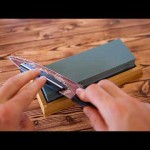
01496a604e98031f9db4a7162a6b008d
Sharpening stones are an essential tool for any woodworker, chef, or hobbyist. Whether you’re sharpening knives, chisels, or other tools, having the right sharpening stone is key to getting the job done right. But with so many different types of sharpening stones available, it can be difficult to know which one is best for your needs. In this article, we’ll provide a sharpening stone grit comparison to help you find the right grit for your project. We’ll discuss the different types of sharpening stones, their grit levels, and how to choose the right one for your needs.
How do you determine the correct grit of a sharpening stone
Sharpening stones are an essential tool for keeping your knives and other tools sharp. But how do you know which grit of sharpening stone is right for your needs? The answer depends on the type of material you are sharpening and the desired level of sharpness.
The grit of a sharpening stone is measured in terms of the size of the abrasive particles on the stone. The higher the grit number, the finer the abrasive particles and the smoother the finish. Generally, the lower the grit number, the coarser the abrasive particles and the more aggressive the sharpening.
For most everyday sharpening tasks, a medium-grit stone (around 1000-3000 grit) is recommended. This will give you a good balance between sharpness and smoothness. If you are looking for a very sharp edge, you may want to use a higher grit stone (4000-8000 grit). For very dull or damaged blades, a lower grit stone (around 400-800 grit) may be necessary.
When choosing a sharpening stone, it is important to consider the type of material you are sharpening. For example, a softer material such as wood or plastic may require a finer grit stone than a harder material such as steel. It is also important to consider the desired level of sharpness. A very sharp edge may require a higher grit stone than a less sharp edge.
In addition to the grit of the stone, it is also important to consider the type of stone. There are two main types of sharpening stones: oil stones and water stones. Oil stones are usually made of aluminum oxide or silicon carbide and require the use of oil as a lubricant. Water stones are usually made of synthetic materials and require the use of water as a lubricant. Each type of stone has its own advantages and disadvantages, so it is important to choose the one that best suits your needs.
In conclusion, the correct grit of a sharpening stone depends on the type of material you are sharpening and the desired level of sharpness. Generally, a medium-grit stone (1000-3000 grit) is recommended for most everyday sharpening tasks. For very dull or damaged blades, a lower grit stone (400-800 grit) may be necessary. For a very sharp edge, a higher grit stone (4000-8000 grit) may be required. It is also important to consider the type of stone, as each type has its own advantages and disadvantages.
What is better 6000 or 1000 grit sharpening stone
Sharpening stones are an essential tool for any knife enthusiast. They come in a variety of grits, ranging from coarse to fine. The two most common grits are 1000 and 6000. Each has its own advantages and disadvantages, so it is important to understand the differences between them before making a purchase.
1000 Grit Sharpening Stone
A 1000 grit sharpening stone is a coarse stone that is used to quickly sharpen a dull blade. It is best used for knives that are very dull or have nicks in the blade. It is also great for removing rust or corrosion from a blade. The downside of a 1000 grit stone is that it can leave a rough finish on the blade, which may require additional polishing.
6000 Grit Sharpening Stone
A 6000 grit sharpening stone is a much finer stone than the 1000 grit. It is used to refine the edge of a blade and give it a polished finish. It is best used for knives that are already sharp, but need a bit of extra refinement. The downside of a 6000 grit stone is that it can take longer to sharpen a blade than a 1000 grit stone.
Which is Better?
The answer to this question depends on the type of knife and the desired result.
If you are looking for a quick sharpening job, then a 1000 grit stone is the best choice. If you are looking for a polished finish, then a 6000 grit stone is the better option. Ultimately, it is up to the user to decide which grit is best for their needs.
What grit should I sharpen my knife
Sharpening a knife is an important part of knife maintenance. It is important to use the right grit when sharpening a knife to ensure that it is sharpened properly. The grit of a sharpening stone is measured in microns, and the lower the number, the finer the grit.
The type of knife you are sharpening will determine the grit you should use. For example, a kitchen knife should be sharpened with a finer grit than a hunting knife. A kitchen knife should be sharpened with a grit of around 1000-2000, while a hunting knife should be sharpened with a grit of around 400-800.
When sharpening a knife, it is important to start with a coarse grit and then move to a finer grit. This will ensure that the blade is sharpened properly and that it is not damaged in the process. It is also important to use a sharpening stone that is appropriate for the type of knife you are sharpening. For example, a ceramic sharpening stone should be used for a kitchen knife, while a diamond sharpening stone should be used for a hunting knife.
When sharpening a knife, it is important to use the correct technique. It is important to use a consistent angle when sharpening the blade and to use light, even strokes. It is also important to use a lubricant, such as oil or water, to help reduce friction and heat.
Sharpening a knife is an important part of knife maintenance and it is important to use the right grit and technique to ensure that the blade is sharpened properly. By using the correct grit and technique, you can ensure that your knife is sharpened properly and that it is not damaged in the process.
Is 600 grit good for knife sharpening
Sharpening a knife is an important part of kitchen maintenance. It is important to use the right grit when sharpening a knife. The grit of a sharpening stone is measured in numbers, with lower numbers indicating a coarser stone and higher numbers indicating a finer stone. So, is 600 grit good for knife sharpening?
The answer is yes. A 600 grit sharpening stone is a good choice for sharpening knives. It is a medium-fine grit, which is ideal for sharpening most kitchen knives. It is also a good choice for sharpening pocket knives and other small blades. The 600 grit stone will remove the dull edge from the blade and create a sharp, smooth edge.
When using a 600 grit stone, it is important to use the correct technique. Start by wetting the stone with water or oil. Then, hold the knife at a 20-degree angle and draw the blade across the stone in a sweeping motion. Make sure to keep the angle consistent and use even pressure. After a few passes, check the blade for sharpness. If it is not sharp enough, repeat the process.
In addition to a 600 grit stone, it is also important to have a higher grit stone. A higher grit stone, such as a 1000 grit, is used to refine the edge and create a polished finish. After sharpening with the 600 grit stone, switch to the higher grit stone and repeat the process. This will create a smooth, sharp edge.
In conclusion, 600 grit is a good choice for sharpening knives. It is a medium-fine grit that is ideal for most kitchen knives. When using a 600 grit stone, it is important to use the correct technique and to follow up with a higher grit stone to refine the edge. With the right technique and the right grit, you can keep your knives sharp and ready to use.
We hope this article has helped you find the right grit for your sharpening stone needs. Thank you for reading and goodbye!











